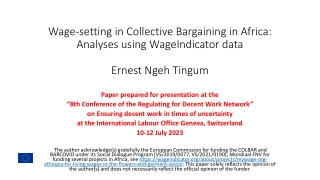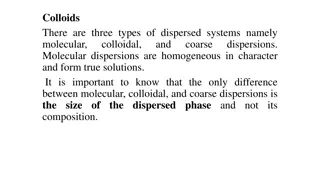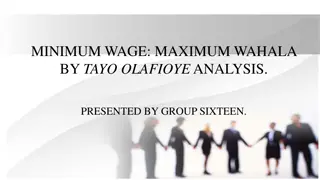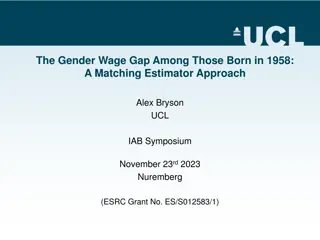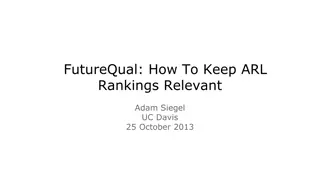Analysis of Wage Rankings and Dispersions in Global Health Workforce
This study delves into the wage rankings, dispersions, and standardized wage levels of 16 health workforce occupational groups across 20 countries. The research objectives include exploring variations in occupations and countries concerning wage levels, dispersions, and rank-orders. Data collected from WageIndicator web-survey of 2008-2011Q1 is utilized to analyze hourly wages, with a focus on understanding wage differentials between different health occupations globally. The findings aim to shed light on the impact of social indices on wage variations among countries.
Download Presentation

Please find below an Image/Link to download the presentation.
The content on the website is provided AS IS for your information and personal use only. It may not be sold, licensed, or shared on other websites without obtaining consent from the author. Download presentation by click this link. If you encounter any issues during the download, it is possible that the publisher has removed the file from their server.
E N D
Presentation Transcript
Can Indices of Social Development explain the wage rankings, wage dispersions, and standardized wage levels of 16 health workforce occupational groups across 20 countries? International Conference: Taking Stock: Measuring Social Development The Hague 14-15 December 2011 Thursday 15 Dec. Kea Tijdens
Introduction World Health Organization (WHO): strengthen knowledge to measure and monitor health workforce capacity to respond to public health needs: Human Resources for Health (HRH) Lack of international databases on health workers' wages ILO October Inquiry: 7 health occupations Data needed among others for understanding migration of health care professionals 02 October 2024 2
Previous findings Enormous wage gap for health workers between rich and poor countries (Drager et al. 2006) Wages great incentives for health workers to migrate (Vujicic et al. 2004) Many national studies detail the job content of the HRH workforce, but few do so in a cross-country comparative way, for example with regard to job differentiation and certification 02 October 2024 3
Research objectives 1) Do occupations vary regarding: a) the standardized wage levels across countries 2) Do countries vary regarding: a) the wage dispersion across the HRH occupations (median wages per occupation) b) the rank-order across the HRH occupations (ranking median wage levels) 3) Can social indices explain the country differences? 02 October 2024 4
Data and methods Data of WageIndicator web-survey 2008-2011Q1 (continuous, multiligual, volunteer, posted on websites in 60 countries targeting labour force) Defining 20 HRH occupational groups, using WHO s Global Atlas for HRH and ILO s ISCO-08 Clustering 100 occupations from survey into 20 HRH groups: insuff. obs for 4 > 16 HRH occ s Sufficient observations in 20 cntries: N = 38,799 Hourly wages expressed in standardized USD, controlled for PPP, all indexed to 2011 levels ISD Data base 02 October 2024 5
1a) Median hourly wages (standard_USD) 80 Medical Doctors 70 Nursing & Midwifery Professionals 60 Personal Care Workers in Health Services 50 40 30 20 10 0 02 October 2024 6
1a) 20-cntr averages of median hrly wages in 16 occs Max_20cntrs 70 Min_20cntrs 60 Ratio_hi_lo_20cntrs 50 SD_20cntrs 40 Mean wage_20cntrs 30 20 10 0 02 October 2024 7
2a) Median wages (standard_USD) in 16 occs Min_16occ 70 Max_16occ 60 Ratio_hi_lo_16occ 50 SD_16occ 40 Mean wage_16occ 30 20 10 0 02 October 2024 8
2b) Rank-order of median wage in 16 occs Findings Medical Doctors rank highest in 11/20 cntrs. Personal Care Workers rank lowest in 9/20 cntrs. Health Care Managers rank lower than Doctors, but higher in 5/20 (BLR, CZE, POL, RUS, UKR) Nursing & Midwifery Professionals vary largely Rank correlations country ranking correlated to average 20-country ranking: correlation >.7 in 7/20 cntrs (see graph) 02 October 2024 9
2b) Rank correlations to 20-cntr mean rank 1 0.9 0.8 0.7 0.6 0.5 0.4 0.3 0.2 0.1 0 02 October 2024 10
3) Explanatory power of Social Indices Do social indices explain wages in the 20 countries? Club and associations explain the country-level mean wages, wage dispersion and wage gap Civic activism and intergroup cohesion explain correlations of national rankorder with overal rankorder Pearson correlations (N=20) Rank corr. Mean wage Wage dis- persion (sd) Wage gap (hi-lo) civic_activism 0.392* 0.442* 0.230 0.215 gender_equality 0.189 0.283 0.128 0.129 intergroup_cohesion 0.416* 0.280 0.075 0.080 interpersonal_safety_and_trust 0.284 0.284 0.165 0.164 clubs_and_associations 0.340 0.580*** 0.524** 0.493** 02 October 2024 11
Conclusions Wage differentials can be studied across countries They provide insight in the occupational hierarchies across countries Limitations: definition of wages across countries are assumed to be similar, but this may not be the case occupational titles are assumed to reflect similar job content across countries, but this may not be the case no information about credentials and impact on wages regional differences and private/public divide not taken into account 02 October 2024 12
The end Thank you for your attention! For more information www.wageindicator.org 02 October 2024 13


